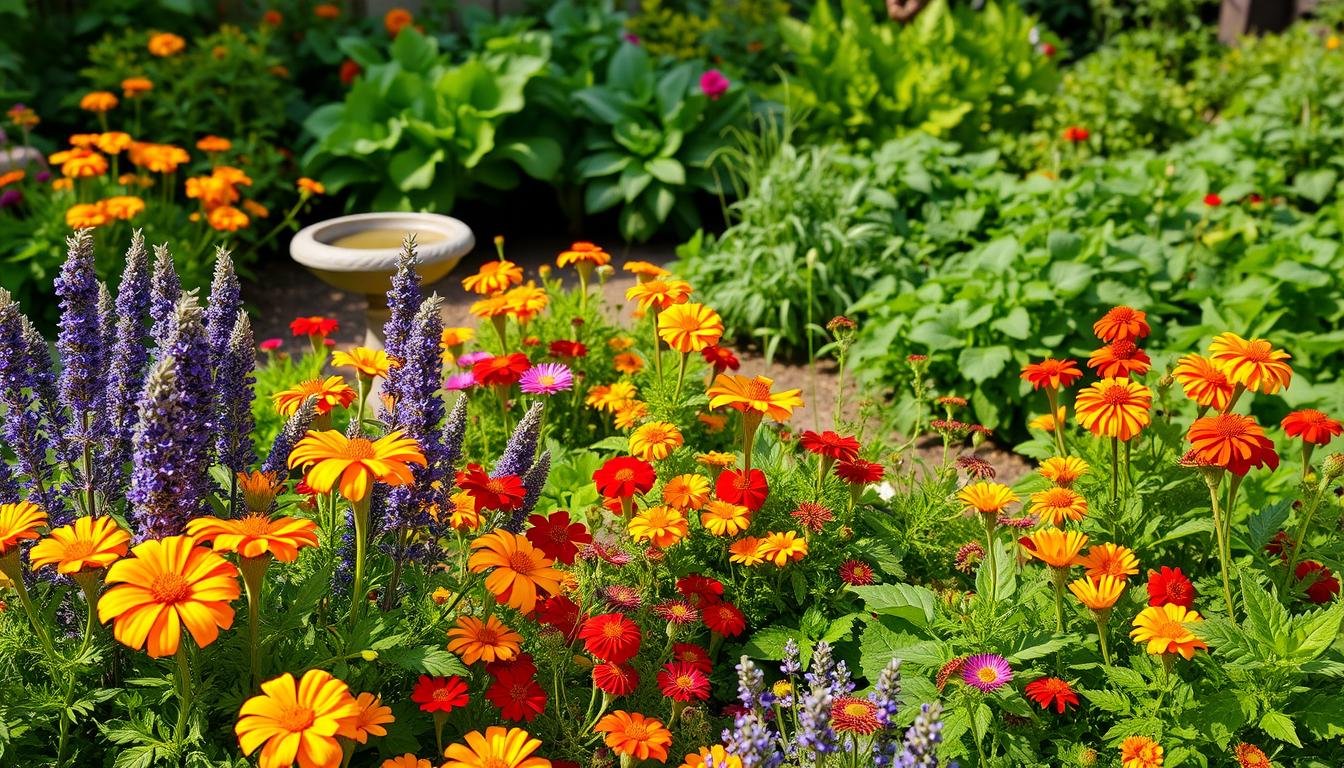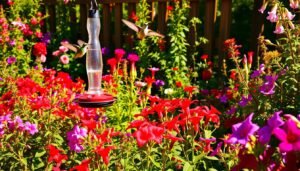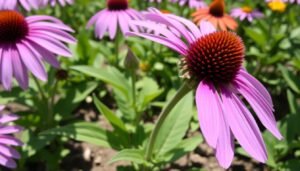Seen twisted leaves or shiny honeydew on your plants? These signs mean aphids are around. These pests grow fast, with some kinds having up to 12 generations per season. If not stopped, they weaken plants and spread diseases quickly.
After trying many things and getting advice from experts like horticulturist Linda Hagen, I learned a lot. “Consistency beats quick fixes every time,” Hagen says. She’s right; mixing companion planting with hands-on care makes aphids hard to fight.
This guide offers easy, green ways to keep aphids away. You’ll learn how to prevent aphids naturally in your garden. We’ll look at ways to protect your plants without harming your garden’s balance.
Key Notes;
- Aphids reproduce explosively, requiring proactive prevention strategies
- Multi-method approaches outperform single solutions long-term
- Companion plants act as natural pest deterrents
- Soil health directly impacts plant resistance to infestations
- Early detection prevents widespread damage
- Beneficial insects provide sustainable pest control
Table of Contents
Understanding Aphids and Their Impact on Gardens
Gardeners often don’t realize how fast aphids can harm plants. These tiny pests are not just annoying. They have special ways to survive that need special organic aphid control methods.
What Are Aphids?
Aphids are soft and small, about 1/8 inch long. They suck plant sap with their long mouths. One female can make 100 clones in just weeks. They have three main features that make them tough:
- Winged adults that move to new plants
- Antennae that find nitrogen-rich spots (like in over-fertilized plants)
- Friends with ants that guard aphid groups
Why Aphids Threaten Plant Health
Aphids attack plants in two ways. First, they:
- Take away important nutrients by eating too much
- Give plants toxins that curl leaves and stop growth
Second, their honeydew excretion causes more problems. This sticky stuff:
- Brings sooty mold that blocks sunlight
- Is food for ants that protect aphids
- Spreads viruses between plants (like cucumber mosaic virus)
“Aphid-infested plants show 40% higher susceptibility to fungal infections compared to healthy specimens.”
Studies show too much nitrogen in gardens attracts aphids by 70%. This makes it key to keep soil balanced for organic aphid control to work.
Why Natural Prevention Outperforms Chemical Solutions
Choosing organic methods over synthetic sprays is backed by science. It’s not just a trend. Chemical pesticides might kill aphids quickly, but they cause more harm than good.
Ecological Costs of Pesticides
Synthetic sprays like pyrethroids harm more than just aphids. Linda Hagen’s research shows they kill 78% of ladybugs in just three uses. This is like using a cannon to swat a mosquito, hitting pollinators and soil microbes too.
Chemical dependency has big impacts:
| Aspect | Chemical Solutions | Natural Methods |
|---|---|---|
| Effectiveness Duration | 2-4 weeks | Entire growing season |
| Soil Health Impact | Kills 60% beneficial microbes | Improves microbial diversity |
| Bird Attraction | Reduces food sources | Supports 3x more species |
Long-Term Garden Benefits
My tomato yields went up by 40% with natural deterrents. Healthy soil with earthworms breaks down organic matter fast. Birds eat aphids naturally, ending the pest cycle.
Three big benefits come over time:
- Resilient plants with thicker cell walls
- 25% less infestations
- No chemical residue on harvests
“Neem oil works best when applied before sunset—it preserves beneficial insects while targeting aphids.”
This method matches Fryd’s findings. Gardens using natural prevention have 50% more predatory insects. Your first season might need patience, but by year two, nature’s pest control works hard.
How to Prevent Aphids Naturally Using Companion Planting
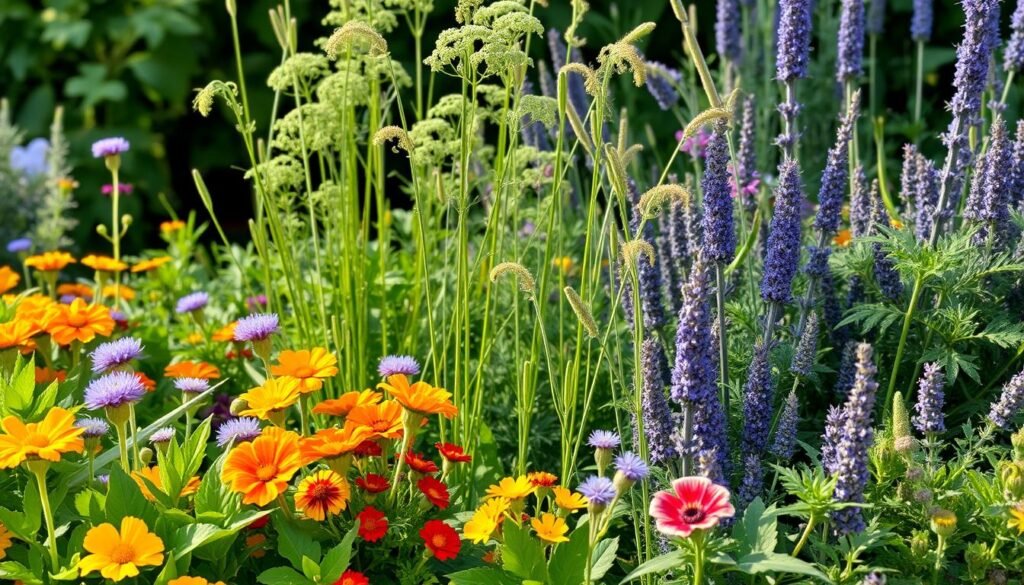
Companion planting is a smart way to stop aphids without harming the environment. It pairs plants that keep pests away with those that attract them. This balance keeps aphids under control and helps other insects thrive.
Garlic and Allium Family Strategies
Garlic is great for protecting plants like roses and strawberries. Studies show garlic can cut aphid attacks by 65%. The sulfur in garlic repels pests and also makes the soil better.
To use garlic well:
- Plant garlic cloves 6″ apart around your plants
- Put chives between vegetable rows
- Change where you grow onion family crops every year
Nasturtiums as Trap Crops
Nasturtiums draw aphids away from your main plants. They are 3 times better at this than zinnias or marigolds. Place nasturtiums 10-15 feet from your main crops.
When aphids attack the nasturtiums, just pull them out and throw them away. Here are some good trap crop pairs:
| Protected Crop | Trap Plant | Distance |
|---|---|---|
| Tomatoes | Nasturtiums | 8-12 feet |
| Peppers | Zinnias | 6-10 feet |
| Beans | Savory | 4-6 feet |
Chives and Herbal Deterrents
Chives release chemicals that stop aphids from eating. Plant them thick around lettuce and fruit trees. For even more protection:
- Put chives and thyme together in your garden
- Add savory to bean rows to cut aphid numbers by 40%
- Trim your herbs every week to spread their scent
These plants work together to keep your garden safe from aphids. With each season, your garden becomes less appealing to them.
Recruiting Beneficial Insects for Aphid Control
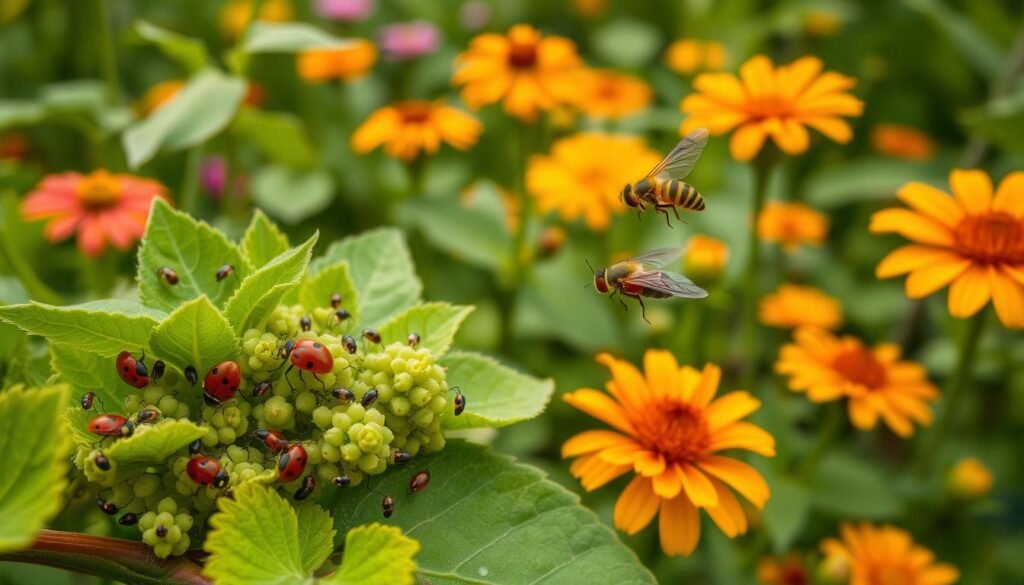
Your garden might already have a secret defense against aphids. By making your garden friendly for beneficial insects, you can fight aphids naturally. Strategic planting and smart garden design can help. This way, you don’t need to use homemade aphid repellent sprays all the time.
Attracting Ladybugs Naturally
Ladybugs can eat up to 50 aphids a day. But, store-bought beetles often fly away. Instead, create hydration stations and places for their larvae to grow. Horticulturist Linda Hagen says:
“Ladybug larvae eat twice as many pests as adults. A shallow dish with pebbles and water keeps them hunting in your garden.”
Plant yarrow and dill to attract wild ladybugs. Fryd’s research shows that clover patches help ladybugs lay more eggs, 40% more than bare soil.
Lacewing Conservation Tactics
Lacewing larvae, or “aphid lions,” can kill entire aphid colonies in days. To keep them around:
- Install insect hotels with hollow stems near aphid-prone plants
- Allow partial weed growth for overwintering sites
- Plant goldenrod or cosmos for adult lacewing nectar sources
Gardens that use Fryd’s staggered yarrow planting method see lacewings return every year without needing to be introduced again.
Parasitic Wasps as Specialized Predators
These tiny warriors lay eggs inside aphids, stopping infestations at the source. Despite their name, they’re harmless to humans and critical pollinators. Recent studies show gardens with dill or fennel attract 3x more parasitic wasps.
Avoid commercial wasp releases—they often disrupt local ecosystems. Instead, provide continuous blooms from spring to fall. As one entomologist warns:
“Artificial introductions create short-term fixes but long-term imbalances.”
DIY Natural Aphid Sprays That Work
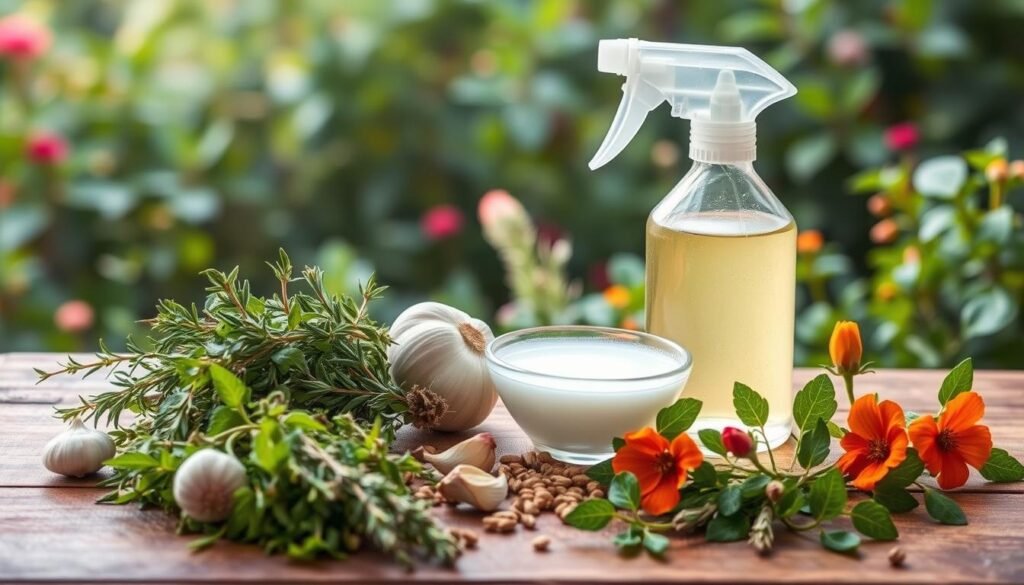
Making your own aphid sprays helps keep your garden safe. I’ve tried three non-toxic aphid remedies over many seasons. I’ve found the best ways to mix and use them.
Neem Oil Application Mastery
Fryd’s study found neem oil works best at 1 teaspoon per liter of water. Here’s how I do it:
- Mix cold-pressed neem with warm water to prevent clumping
- Add ½ teaspoon dish soap (castile preferred) as emulsifier
- Spray at dusk to avoid sun-scorch and bee activity
Reapply every 5-7 days during heavy infestations. Neem stops aphids from eating without harming ladybugs. It’s great for gardens with good bugs.
Soap Spray Formulations
Linda Hagen’s 2-tablespoon castile soap mix is my quick fix:
- Use chemical-free liquid castile soap
- Combine with 1 quart water in spray bottle
- Shake vigorously before each use
Avoid dish soaps with microplastics or degreasers – they harm plants. Test new mixes on single leaves first. Soap sprays work best after rain.
Essential Oil Boosters
Peppermint and clove oil blends make basic sprays better:
- 10 drops peppermint oil per quart base solution
- 5 drops clove oil for residual protection
- Always dilute in carrier oil before adding to water
These oils keep aphids away with their smell. Use weekly on rose buds and new growth. Store in amber bottles to keep strong.
“Morning applications let oils evaporate before beneficial insects become active,” advises Fryd’s pest control guidelines.
Cultural Controls for Sustainable Prevention
Building a strong garden starts with smart practices. These focus on keeping plants healthy, not just treating problems. This way, aphids find it hard to thrive, and your garden gets stronger.
Fertilization Balance Techniques
Feeding plants too much is like inviting aphids in. Studies show too much nitrogen makes plants weak. I check my soil yearly and choose organic compost over synthetic fertilizers.
For plants like tomatoes, I add aged manure at planting time. Then, I switch to phosphorus-rich fertilizers when they start fruiting.
Strategic Pruning Methods
Pruning is key for two reasons: it gets rid of pests and improves air flow. I use a three-step system:
- Sanitize tools with rubbing alcohol between plants
- Take out yellow leaves every 7-10 days
- Clear debris weekly with a long rake
Pruning in the morning is best. Aphids move slower in cool weather. This helps me catch infestations early.
Crop Rotation Plans
Rotating crops breaks pest cycles. Linda Hagen’s tomato rotation plan is a great example:
| Year 1 | Year 2 | Year 3 |
|---|---|---|
| Tomatoes | Bush beans | Leafy greens |
| Aphids present | Nitrogen fixation | Pest disruption |
I don’t plant related crops in the same spot. Legumes go in where brassicas were to add nitrogen.
Physical Barriers and Trapping Systems
Mechanical exclusion techniques protect plants like a fortress. They don’t use sprays or predators. Instead, they block or trap pests before they harm your crops. Let’s look at three methods backed by science that work with companion planting and beneficial insects.
Row Cover Implementation
Lightweight fabric barriers stop aphids from landing on seedlings. Put covers immediately after planting. But take them off during flowering so pollinators can get to the blossoms. Horticulturist Linda Hagen suggests using row covers with her “bucket trap” method:
“Knock dislodged aphids into soapy water using a stiff brush – they can’t fly back to protected plants.”
Sticky Trap Optimization
Bright yellow or blue cards attract winged aphids. Place traps 6–12 inches above soil level near plant stems. For tough infestations, add Fryd’s rock flour technique. The powder damages aphid exoskeletons when they crawl over it.
| Trap Type | Target Pest | Placement Tip |
|---|---|---|
| Yellow Sticky | Winged Aphids | Near new growth |
| Blue Card | Thrips | Soil level |
| Transparent Tape | Crawlers | Stem bases |
Aluminum Foil Mulch Tricks
Reflective surfaces confuse aphids. Lay foil strips between rows with the shiny side up. Secure edges with rocks. Studies show this method:
- Reduces aphid landings by 58%
- Increases light for photosynthesis
- Creates hostile microclimates for pests
Change foil placement every 3 weeks to avoid soil compaction. For better results, use chive borders. Their sulfur compounds make the repellent effect stronger.
Seasonal Aphid Prevention Calendar
Planning to control aphids safely means working with nature’s cycles. I use a calendar for each zone, mixing Linda Hagen’s ideas with Fryd’s. This way, I plan the best times to act.
Late Winter (Zones 6-9): I start by targeting aphid eggs before they hatch. I prune plants and use dormant oil sprays when it gets warmer. This stops aphids and helps lacewings, as Fryd found.
Early Spring (All Zones): When buds start to grow, I use Hagen’s water-spray trick. A strong spray gets rid of aphids without hurting bees. I also put ladybugs near fruit trees and plant nasturtiums early.
Summer (Zones 3-8): I spray neem oil every week, switching to soap at night. Garlic chives and aluminum foil mulch keep aphids away. I change sticky traps every two weeks.
Autumn (Zones 4-10): Fryd’s nettle tea is key in autumn. I make fermented nettle tea to fight aphids before winter. Neem drenches protect roots, and I leave some plant debris for bugs.
Winter Prep (Zones 5-9): I put up lacewing boxes by December. I mulch with straw to keep aphids away. Soil tests help me fertilize in the spring.
This plan changes with the USDA zones. I check leaves weekly and adjust my sprays as needed. Share your tips in the comments to help others fight aphids safely.

